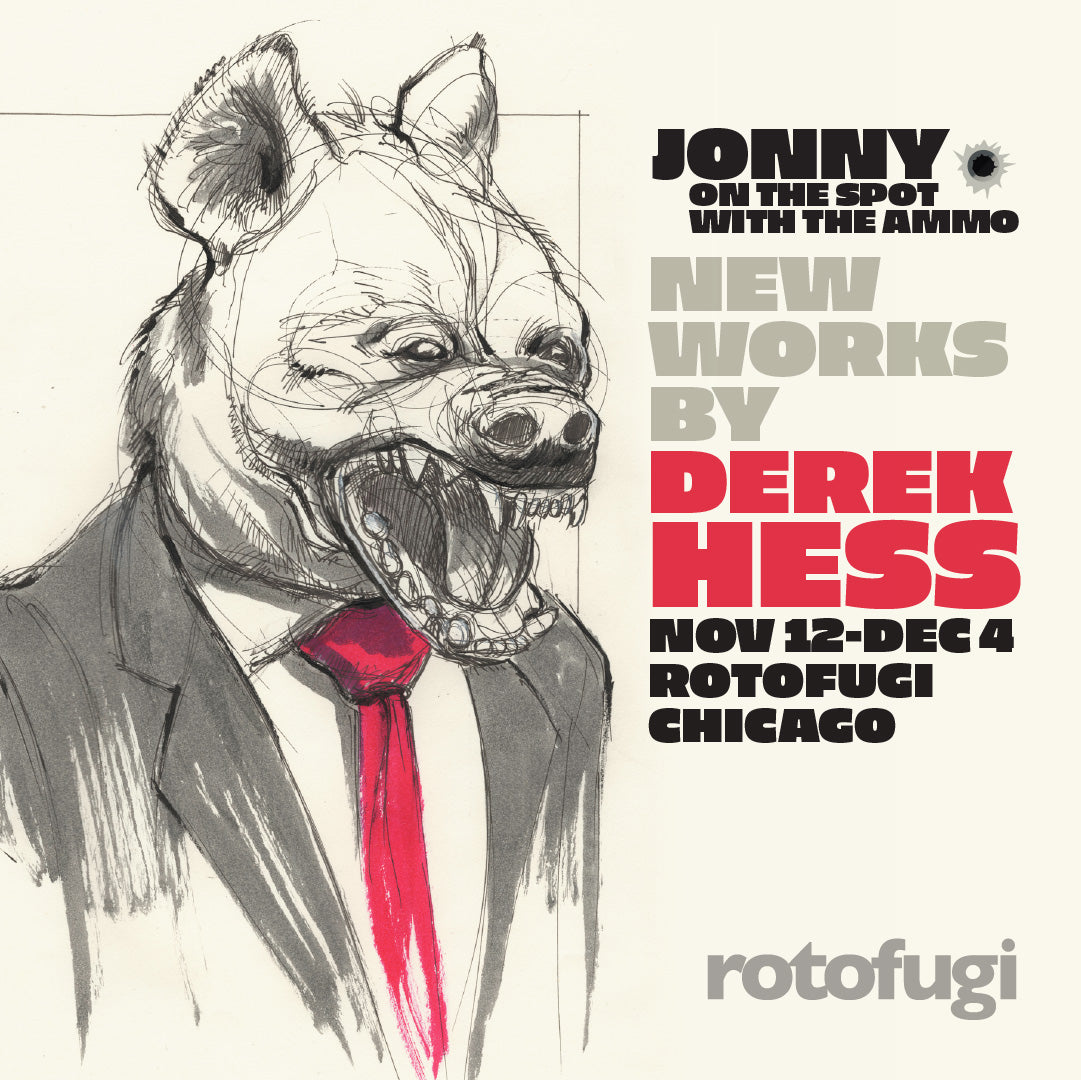
November Exhibit: Derek Hess
We welcome back one of our all time favorites in the gallery this month! After rising to prominence during the 1990's gigposter revival, Derek Hess has continued to grow as an artist for the past three decades, while also championing mental health.Join us beginning November 12 for an all new exhibit of drawings and paintings by Derek, his first exhibit with us since 2015's "Greatest Hits."
Jonny on the Spot with the Ammo
New Works by Derek Hess
November 12-December 4, 2022
Open 10am-6pm Daily
View in person at Rotofugi, 2780 N. Lincoln Ave., Chicago or online at gallery.rotofugi.com (after the exhibit opens).
For first opportunity to purchase online, please visit previews.rotofugi.com to sign up for our Gallery Previews email list.
——
About the Artist
Since he first emerged as the most artistically capable figure in the 1990s poster art renaissance, Derek Hess has made a name for himself in the worlds of fine arts, album covers, apparel design, tattooing, and even music festivals. Though he explores dark and intense themes, he’s nonetheless made art so broadly appealing that his work has been collected in the Louvre, the Rock and Roll Hall of Fame, and in tattoo parlors—and Hess is equally proud to be in all of those places.
Born in Cleveland in 1964, Hess’ ascendance in the arts should probably come as little surprise. His father, Roy Hess, was a noteworthy designer, and chairman of the lauded industrial design department at the Cleveland Institute of Art. From a young age, Hess was correctly trained in classical art and design.
Hess studied at that school, and at the Center for Creative Studies in Detroit, but he never landed in his father’s department, trying out illustration and graphic design before settling on a major in printmaking. It was that discipline, combined with his love of music, that led Hess to poster art fame. He had begun booking post-hardcore and underground rock concerts at the Euclid Tavern, a divey blues bar across the street from the Cleveland Institute of Art, and he drew his own fliers to promote his shows. It didn’t hurt that Hess was musically ahead of the curve, booking then-unknowns like Helmet, Green Day, and Melvins at a time when the other clubs in town couldn’t have cared less.
But as that music scene grew, people started taking as much note of Hess’ distinctive fliers as of the bands themselves—his imagery was perfect for the music’s sound, a contradictory chimera of (and sly commentary on) toughness and fragility, grandiose posturing in the face of fatalism. Though he preferred a very casual, loose, sketchy line, it was clear that Hess paid attention in anatomy class, and his work won high praise from art-world mavens who couldn’t have cared less about Cop Shoot Cop.
“I was excited about these bands,” Hess said, “and I could draw, so I just went ahead and did it. There was always inspiration to work from in the bands’ names, or their images, or just whatever their music made me feel like drawing. People started noticing the art, and then people started putting that imagery with the club, in their minds. And THEN it started to become about the artist that did all the cool fliers for the cool club that had the cool bands.”
Hess’ fliers caught the eye of gallerist Marty Geramita, who convinced Hess to level up from photocopied fliers into silkscreened posters, and formed a business devoted to that pursuit. It was from there that Hess became internationally known, creating posters for Pearl Jam and Pink Floyd; album covers for Sepultura, Converge, and R.L. Burnside; and launching the Strhess apparel line, which itself spun off into a traveling music festival.
Since then, Hess has eschewed most commercial work, focusing on original drawings and fine art serigraphs. In the 2014 documentary film Forced Perspective, Hess opened up publicly for the first time about his struggles with bipolar disorder and alcoholism, and the outpouring of fan support led him to mental health activism. He formed Acting Out! to help spread awareness of mental illness among creative people, devoted to panel discussions and arts across all disciplines, including music, comedy, visual art and film.
“Most of the emotions my work relates to are those that can be seen as the ‘negative' ones,” said Hess. “My work isn’t happy, there’s angst, depression, loss, fear, and loneliness in my work. Drawing the essence of emotions is elemental—we as a species will ALWAYS have heartache. It’d be deeply satisfying in my work stood the test of time, if it would be as relevant to someone in a hundred years as it felt to me the day I drew it.”
